Quick, what's the first thing that comes to your mind when I say "aesthetic medicine"?
Is it a lady getting her botox done? Her lip filler? Or perhaps a freshly sculpted Brazilian butt lift?
Whichever one it is, I bet that a man getting his anything done – didn't even crack your top three.
I'm not surprised. Historically, the cosmetic medicine industry has been carefully crafted to target women - every ad, every treatment, wrapped up in soft pinks and pastels, speaking directly to the female experience.
Men, on the other hand, have never been strategically targeted, because of the well-known stereotype that a man engaging in beautification makes him somehow "less manly." And there is no greater disrespect to a man than to challenge their very manhood. It's as if wanting to get rid of some wrinkles means he might just as well start putting on lipstick and calling himself Candice.
Nothing wrong with that though, Candice, I think you are a babe.
That stereotype kept male beauty treatments limited to grabbing whatever 5-in-1 soap was on sale - you know, the one that promises to wash your face, skin, car… and other things.
But let's be honest: while ladies have been exploring every beauty trend under the sun, us men have been lurking in the shadows, quietly googling "how to look less like a potato" (or is that just me?).

And for good reason: why should women be the only ones to take care of their appearance? Can men not attempt to defy aging without stigma? With the landscape shifting, more men are realizing that a bit of "bro-tox" or a 30-step skincare routine doesn't make them any less of a man - it makes them a more confident one.
The only problem? The industry hasn't prepared to cater to men yet, and marketing aimed at male patients is extremely limited. So while men are showing interest, they're left feeling like they're crashing the wrong party.
It's time for a change - the male market is ready to emerge from the "man cave" into the world of anti-aging and cosmetic treatments. However, to make that change, practices must prepare. It's not as simple as placing a sign saying "Men Welcome, (I guess)."
Just as every practice has identified their perfect patient personas, men are no less diverse, contrasting, and complicated (just ask my girlfriend). Practices cannot simply hold the "build it, and they will come" mentality. To truly succeed, you must understand that men also require connection - the visceral desire to capture confidence in a bottle.
Want to finally tap into the burgeoning male patient market? Then keep reading and learn how to convert the most fragile of us all.
Why Men Want Aesthetic Treatments
So what's driving men to finally step out of the shadows and into aesthetic clinics?
It's not just vanity (though let's be real, we're all a little vain). There's a complex web of motivations that's pushing men toward treatments they wouldn't have been caught dead considering just a decade ago.
The Confidence Factor
Let's start with the obvious: confidence.
Men want to look good for the same reason women do - because looking good feels good. But here's where it gets interesting. While women have been socially permitted to openly discuss their insecurities and seek solutions, men have been expected to just "deal with it."
Well, guess what? We're done dealing with it:
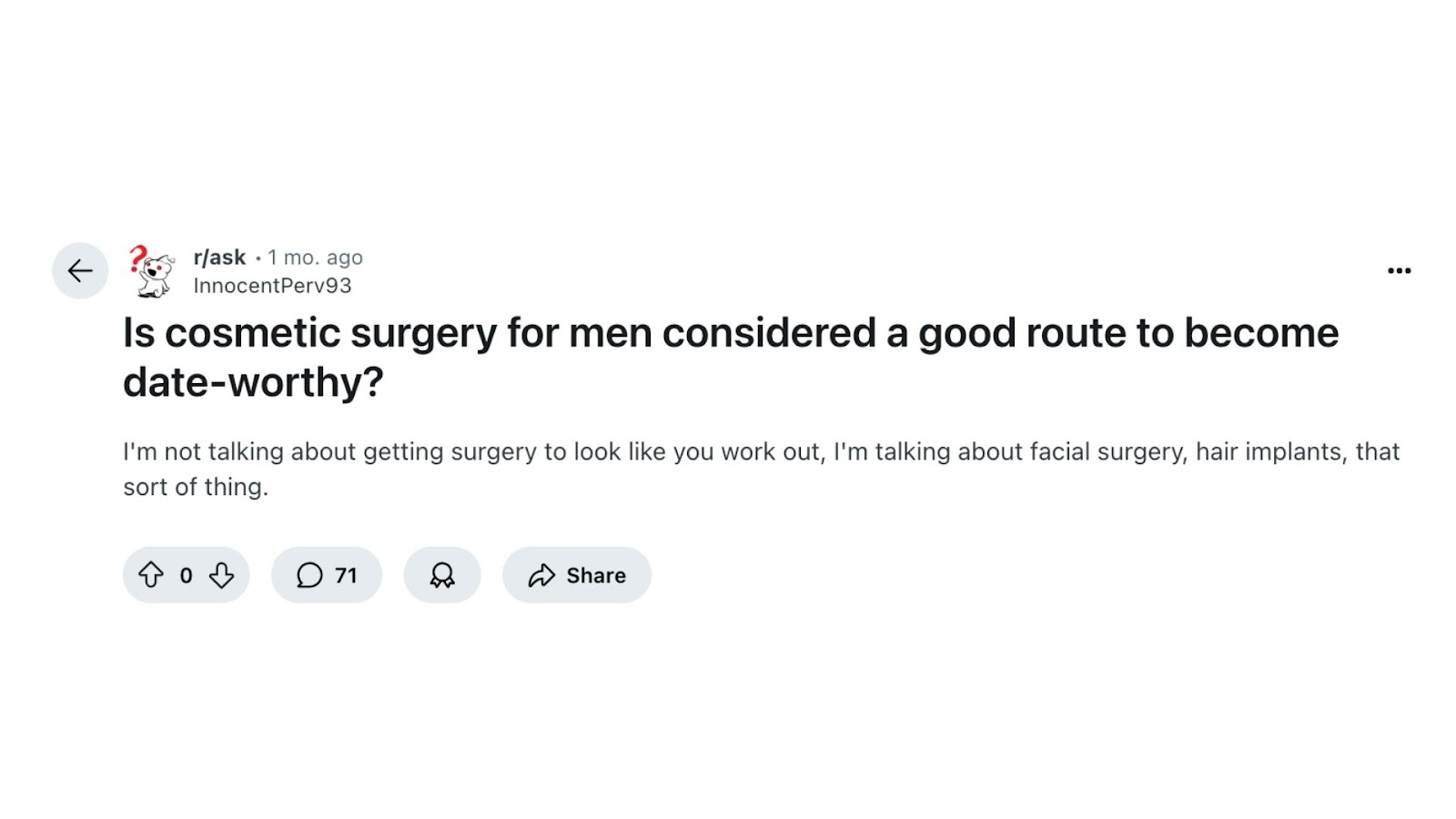
…And even though the majority of males is still unfortunately stuck in the old mindset:
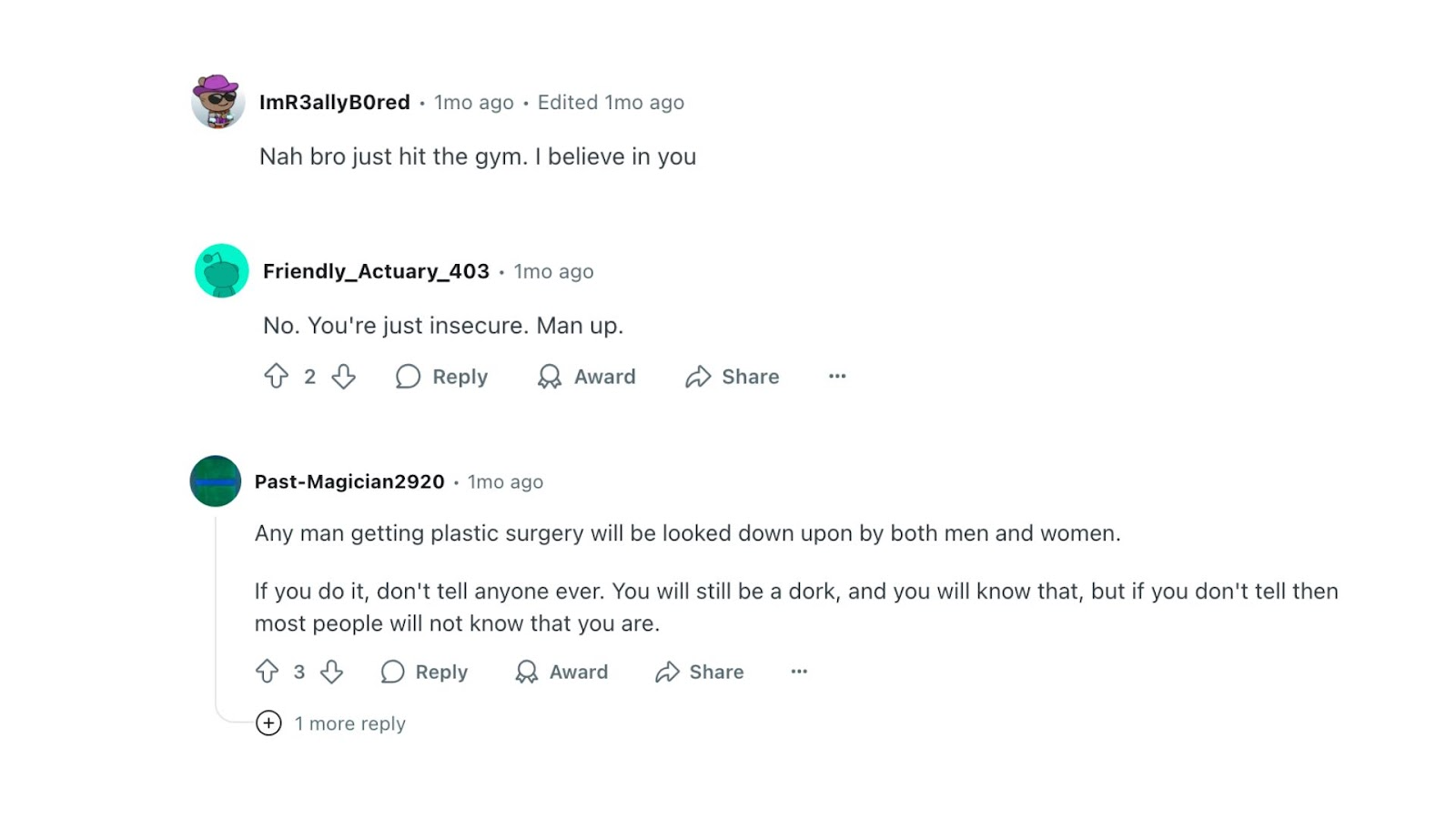
The new era of male aesthetics is slowly taking over:
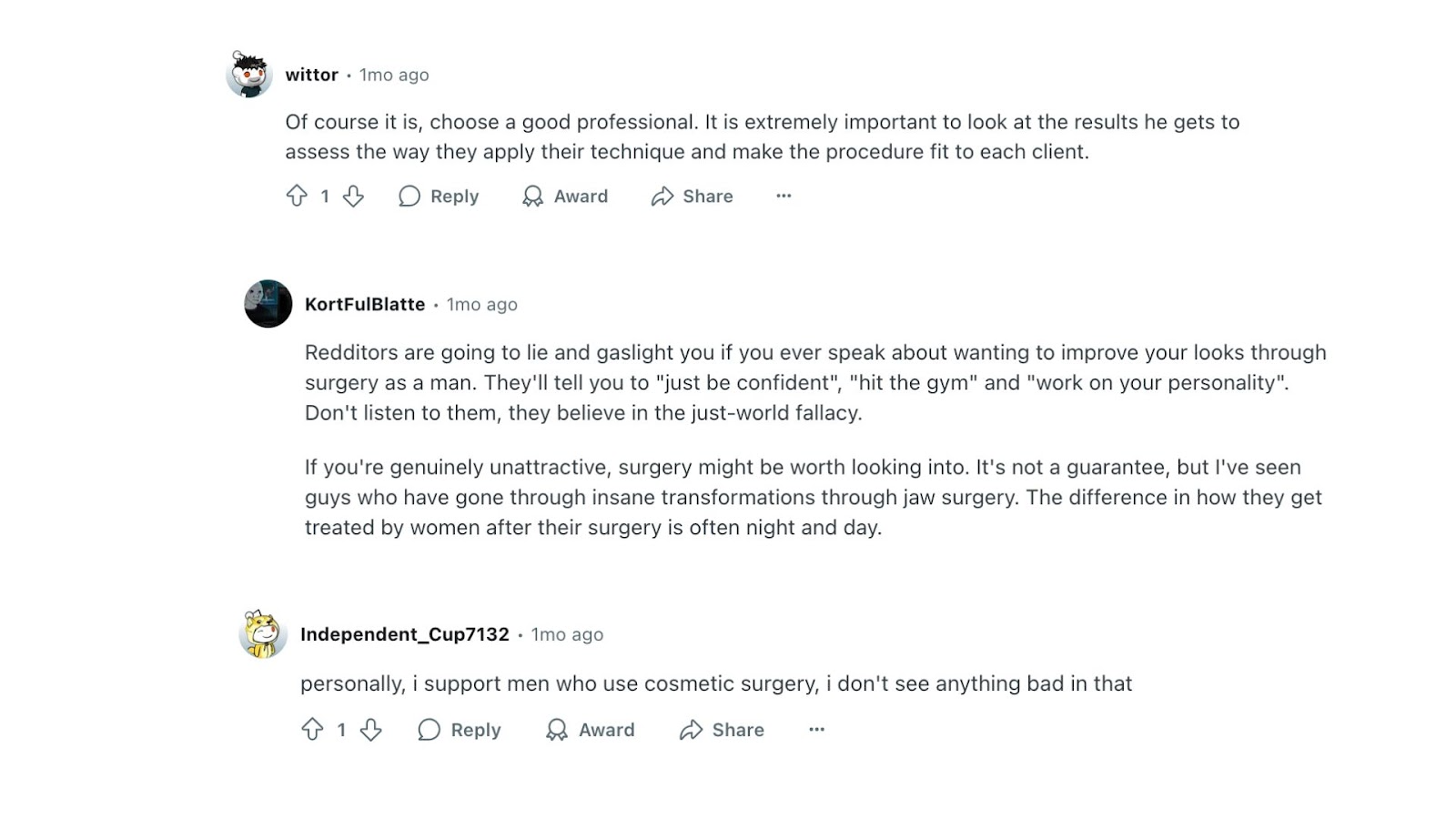
Thanks to the forward-thinking men, normalizing the desire to feel more confident makes guys increasingly comfortable talking about aesthetic treatments:
That receding hairline isn't just a "natural part of aging" anymore - it's a problem with a solution. Those under-eye bags aren't "character" - they're making us look tired when we feel energetic. And that double chin? It's not adding gravitas to our appearance - it's just annoying.
Men are finally realizing that wanting to look attractive doesn't make them feminine - it makes them human. It's about feeling like the outside matches how we feel on the inside. Because let's face it: even if our faces are telling a different story, most of us still feel 25 in our heads.
The Social Media Effect
Social media has done something unprecedented in male aesthetics: it’s made taking care of yourself not just okay, but aspirational.
Suddenly, men are sharing their skincare routines, showing subtle Botox results, and basically normalizing self-care in ways traditional marketing never could:
And this is huge. Because for the first time, men are realizing they can actually do something about those insecurities they’ve been looking at in front of a mirror. Seeing other guys take action makes aesthetic treatments feel normal, approachable, and even smart.
But here’s the duality of it all: social media is also one of the factors driving men to aesthetic treatments because it makes us stare at ourselves too much. Endless scrolling, constant comparison, curated perfection everywhere—it amplifies insecurities we didn’t even know we had. A subtle wrinkle here, a sagging jawline there, suddenly feels like a problem you need to fix yesterday.
So while social media shows men that treatments are possible and acceptable—prompting them to consider aesthetic medicine for the first time—it’s also fueling insecurities, giving them even more reasons to think about improving their appearance.
The Self-Improvement Movement & Gym Culture
If you think about the typical gym bros, you probably picture hyper-masculine, rugged guys pumping iron—definitely not worrying about jowls, acne or other aesthetic issues.
But here’s the interesting part: the same men who spend hours sculpting their bodies with weights are now extending that self-improvement mindset to their faces - inspiring other males to consider the same.
After all, if you’re already putting time, money, and effort into looking better through fitness, why stop at the neck? Gym culture is currently revolutionizing male aesthetics in a way that feels masculine, goal-oriented, and results-driven. It’s not about being pretty—it’s about being the best version of yourself:
Gym bros already talk about their gains, their macros, their supplements, their recovery routines. That's why adding aesthetic treatments to that conversation feels like a logical next step, not a departure from masculinity.
It's all part of the same self-improvement journey - just with different tools.
The Professional Edge
Here's the uncomfortable truth that no one wants to say out loud: looks matter also in the job market.
In a competitive environment, looking tired, old, or worn down can be a liability. And men are increasingly aware that their appearance impacts their professional opportunities, especially in industries where youth and vitality are valued (hello, tech, sales, entertainment). The aesthetic treatments aren't just about looks in this case - they're about staying competitive:
It's not fair, it's not right, but it's reality. And men are trying to adapt accordingly - finally willing to explore the world of aesthetic procedures.
The Modern Masculinity
Perhaps most importantly, men are finally giving themselves permission to care about their appearance without justifying it as something else. We can admit that we want to look good because looking good makes us feel good, and feeling good improves every other aspect of our lives.
Modern masculinity includes taking care of yourself - mentally, physically, and yes, aesthetically:
Because let’s be real: a generation ago, most guys wouldn’t have been caught dead even thinking about Botox, let alone walking into a clinic. Fast forward to now, and while the stigma is still here (which we’ll get into in a second), it’s loosened up just enough to give men the courage to finally say, “Why not me?”
Considering all these motivations men have to try aesthetic procedures, why is it that they never actually make it to the consultation room?
Why They Never Pull the Trigger
So now we know men DO want aesthetic treatments. They're googling "male Botox" at 2 AM, screenshotting before-and-after photos, and mentally calculating how many sessions it would take to fix that thing that's been bothering them for years.
But here's the plot twist: they're not actually booking appointments.
Despite all the internal motivations, or the growing acceptance, most men are still sitting on the sidelines. They want in, but they're not pulling the trigger.
Why is that?
Because wanting something and actually doing something about it are two very different things, especially when you're navigating a minefield of societal expectations, judgment, and an industry that's still figuring out how to even talk to you.
The Toxic Masculinity
We all know traditional masculinity is not exactly associated with caring about your appearance beyond basic hygiene.
Society has spent decades hammering home the message that real men focus on being strong, successful, and stoic. Appearance? That's women's territory. Men are supposed to be valued for what they accomplish, not how they look accomplishing it. We're supposed to age gracefully (translation: suffer in silence) and embrace our "distinguished" gray hair and deepening lines as signs of wisdom and experience.
The internal battle is real. On one hand, you want to do something about those crow's feet. On the other hand, you can practically already hear your father's voice saying "back in my day…"
That’s why this mental war is usually lost before it even begins—buried under the shame of simply trying to book a consultation.
The Judgment Factor
Men know that if word gets out about their lip filler or their subtle nose job, they'll face a different kind of judgment than women do. While a woman might get a jealous "She looks so fake" comment, a man is more likely to get "Really? You got work done?"
(...said with the same tone you'd use for "Really? You collect My Little Pony figurines?")
The stigma is still real and it's powerful. Men worry about being seen as insecure, high-maintenance, or - worst of all - feminine. Because apparently, wanting to look good is still coded as a feminine trait, despite the fact that literally almost every action movie star, athlete, and male celebrity has had some form of aesthetic enhancement.
But try explaining that to your poker buddies when they notice your forehead doesn't move anymore.
The result? Men who desperately want treatments but are paralyzed by the fear of social consequences. They'd rather live with their insecurities than risk being the subject of locker room gossip or workplace whispers.
The Marketing Desert (Where Men Go to Feel Invisible)
Now let's talk about something that makes this whole situation worse: the aesthetic industry's marketing approach to men, which can best be described as "exclusion with a side of awkwardness."
Walk into most aesthetic clinics and you'll be greeted by a sea of imagery featuring women with flawless skin, pouty lips, and perfect cheekbones. The messaging speaks to female experiences, uses feminine language, and assumes female motivations. It's like entering a store where every single advertisement features people who don't look like you, talking about problems you don't relate to, using language that feels foreign.
Men see this kind of marketing and immediately think: "This isn't for me." And honestly, can you blame them?
What’s even worse, when practices actually do attempt to market to men, they often get it spectacularly wrong, not knowing how to speak the male aesthetic language.
(Part of the problem is not creating detailed patient personas - but that’s a whole another discussion).
All this amounts to a marketing landscape that either ignores men entirely or makes them feel like they crashed the wrong party whenever they show any interest in aesthetic treatments.
The Lack of Customization
Even though the actual treatments may be the same for both genders, men and women want different results from them, and the industry has been slow to catch up to that reality.
So while women crave fuller lips, higher cheekbones, or more dramatic transformations, men typically want subtlety - they want to look refreshed, not different. But when you see most treatment options, they seem designed only with female aesthetics in mind and the protocols often don't account for male facial structure, skin thickness, or aesthetic goals.
Some male aesthetic patients had to learn this the hard way…
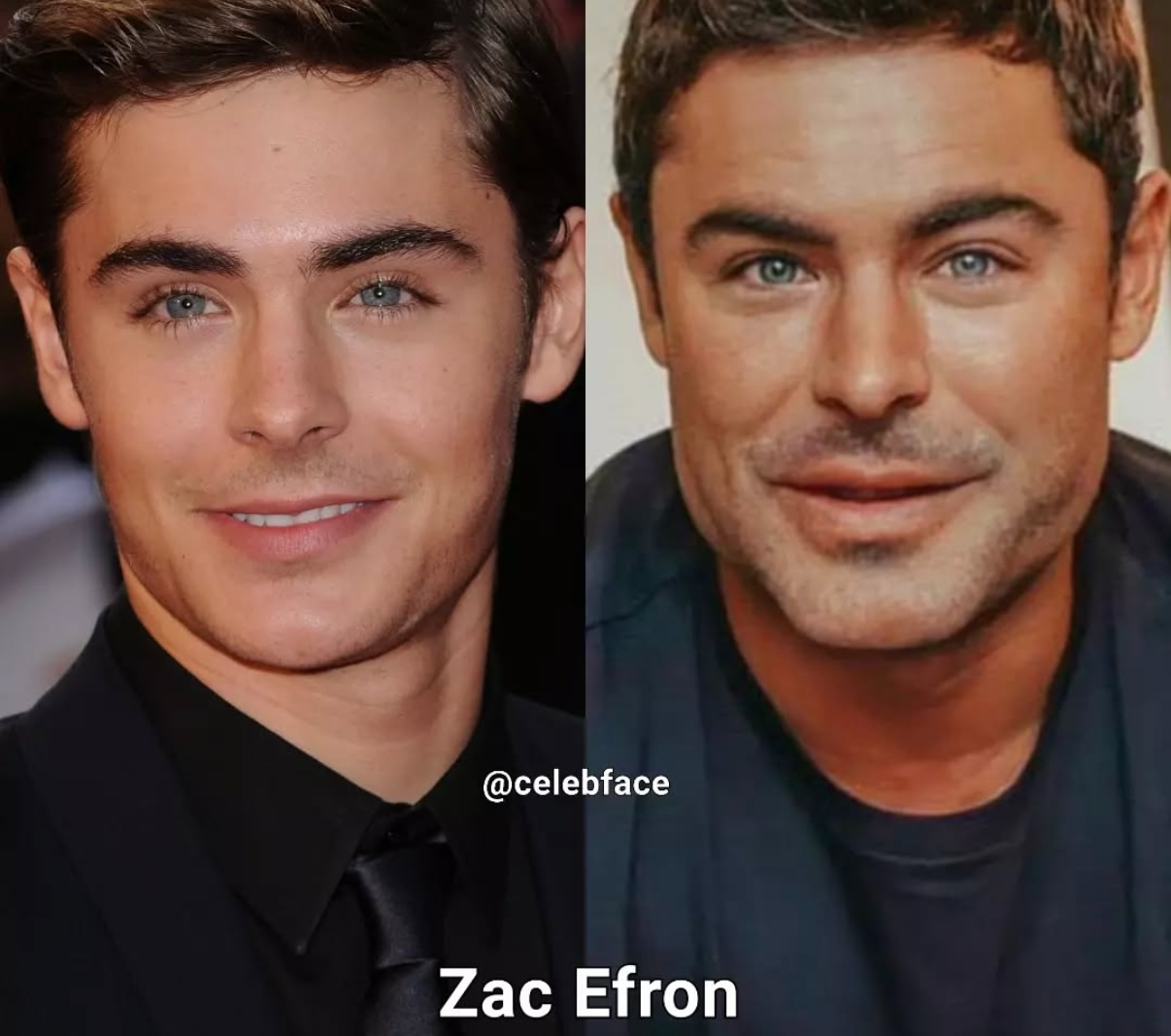
It's not that the treatments can't work for men - it's that the industry hasn't done a great job of showing men how these treatments can work for them specifically:
The Educational Gap
Here's the thing: women walk into aesthetic consultations armed with knowledge. They've researched procedures, know the terminology, and can articulate exactly what they want. They come in talking about neuromodulators and hyaluronic acid fillers. They've watched YouTube videos, followed aesthetic injectors on Instagram, and discussed options with friends who've had work done.
Most aesthetic practitioners have spent years having these educated conversations with female clients. They're used to patients who know the difference between Botox and Dysport, and who can point to specific before-and-after photos saying "I want this, but not that."
But when a man walks in? He knows he doesn't like how he looks, but he has no idea what's available to fix it. He's never heard of a PDO thread. He doesn't know that there are different types of fillers for different areas. He's probably never even considered that there are non-surgical options for things that bother him.
The practitioner assumes a baseline level of aesthetic literacy that simply doesn't exist in the male market. They start talking about treatment options using language and concepts that are completely foreign to male clients. It's like having a car mechanic assume you know what a carburetor does when you just know your car makes a weird noise.
That’s why when men are already stepping outside their comfort zone and the conversation immediately goes over their head, that educational gap becomes another barrier to move forward.
The Perfect Storm of Inaction
Put it all together and you have a perfect storm: men who want aesthetic treatments but are trapped by societal expectations, afraid of judgment, confused by marketing that doesn't speak to them, overwhelmed by options that don't seem relevant, and facing a consultation process that doesn't feel right.
Is it any wonder they're not booking a visit at your aesthetic practice?
The tragedy is that many of these barriers are completely solvable. The treatments work just as well on men. The results can be just as transformative. The confidence boost can be just as significant.
But first, aesthetic clinics need to make the move and show men they have exactly what they're looking for - not just the treatments, but the understanding, the approach, and the results that actually make sense for male clients.
Men are Complex Creatures Too
Alright, we've established that men want aesthetic treatments but are trapped in a maze of barriers, confusion, and industry indifference. The question now is: how can you change that?
First things first: just like your female clients, men aren't a monolith.
Shocking, I know.
Most practices have already figured out that they need different personas for different types of female clients - the soccer mom wanting subtle refreshing, the influencer seeking dramatic enhancement, the executive looking for a professional polish. But when it comes to men, there's often this assumption that a "male client" is a persona in itself.
Plot twist: it's not. Let’s say we have two guys:
The first one is 45 years old, straight, works in finance, wants to look less tired for client meetings, and values discretion above all else. He Googles treatments at 11 PM under his covers and would rather undergo root canal surgery than have his golf buddies know he got Botox.
The second’s 28 years old, queer, works in social media marketing, follows male grooming influencers, and sees aesthetic treatments as part of his personal brand optimization. He'll probably post his consultation on Instagram stories just to make some interesting content.
Now, think about how you could possibly market to both of them in the same way?
So while their gender may be the same, these two gentlemen require completely different approaches - and you need to honor their distinct needs and motivations. There are likely several other male personas specific to your own practice. There isn't a one-size-fits-all template you can copy and paste. Your male patient personas will vary significantly depending on your specific services, your geographic location, your price points, and even your practice's reputation.
Keeping that in mind, it’s time to get a bit more specific - remember our old friend?
Welcome back, David!
If you’ve been reading IM+ carefully (and for those who haven't been - I’m watching YOU!) you’ve already met David:

David is a 50-year-old IT consultant who we identified in our Patient Personas series, which I highly suggest you read. David is BACK - and he is finally ready to do something about the face staring back at him during those Zoom calls. He's interested in rhinoplasty, a neck lift, and a hair transplant.
His biggest concerns? Recovery time (he can't miss client calls), potential complications (WebMD is both his best friend and worst enemy), and finding a surgeon who actually knows what they're doing.
David's motivated by wanting to look more youthful and feeling confident in professional settings - he's tired of 25-year-old developers calling him "sir" and wants to improve his self-image without looking like he’s trying too hard.
With $20,000 to $25,000 in spending power—finally ready to invest his consulting rates in something other than the latest MacBook—David wants results but also wants to make sure he can still hop on client video calls without anyone suspecting he had work done.
And while, as we already established, there are multiple patient personas specific to each practice, for the sake of this article, we're going to use David as our example.
He embodies the qualities of the most challenging male demographic to attract to aesthetic practices - the traditionally masculine, straight professional who's never considered aesthetic treatments before (as opposed to, say, men from the queer community who are generally more comfortable with aesthetic and beauty concepts).
So, how do you actually market to David?
Direct Marketing
One of the ways to crack the male patient code is starting to speak directly to David, in his own language. Not rocket science, but apparently challenging enough that most practices are still failing at it spectacularly. Here's how to get it right:
SEO
For a moment, forget everything you learned about medical SEO - all the beauty-related longtail keywords or the ones tied to specific treatments that most males have never even heard of.
Instead, first try to think of what David’s search journey actually looks like - because it's completely different from how ladies research aesthetic treatments.
Keyword Strategy
When it comes to female patients, they mostly search proactively. They'll Google lip filler specialists and spend hours comparing results because they've been thinking about enhancing their lips for months. They research different techniques, read reviews, join Facebook groups to see before-and-after photos. It's a planned journey.
David? He searches reactively. He doesn't wake up thinking "I should research some aesthetic enhancement options today." He Googles "how to not look like shit" at 2 AM after his ex posts vacation photos with her new boyfriend who's clearly younger. Or while he’s getting ready for a work presentation and suddenly notices how tired he looks compared to his younger colleagues.
Because of that, David (and other patients like him) typically go through three distinct search phases:
Phase 1: Problem Recognition (High Emotion, Low Knowledge)
This is where David types queries like:
- "Why do I look so tired all the time?"
- "Getting fat under my chin"
- "Looking older than I am"
- "Face looks droopy"
- "Always look exhausted even when I'm not"
Notice the language? It's frustrated, direct, and focused on the problem, not potential solutions. He’s not yet thinking about treatments - he’s just trying to figure out what's wrong.
Phase 2: Solution Research (Medium Emotion, Growing Knowledge)
Once David realizes his problem might be fixable, he starts searching for solutions:
- "Fix double chin without surgery"
- "How to look less tired naturally"
- "Male Botox before and after"
- "CoolSculpting worth it for men"
- "Best way to tighten jawline"
Now he’s discovering that aesthetic treatments exist for men, but he’s still skeptical and needs proof it works.
Phase 3: Provider Selection (Lower Emotion, High Intent)
Finally, David’s ready to find his aesthetic provider:
- "Male Botox [city name]"
- "Best CoolSculpting for men in [city name]"
- "Aesthetic clinic men [location]"
- "Male cosmetic surgery reviews"
The entire journey David goes through might happen in one night, or over a few weeks, but it's different to a typical female patient search journey.
Why does this matter for your SEO strategy?
Most aesthetic practices are optimizing for Phase 3 keywords - the ones with clear commercial intent. But David is starting his research in Phases 1 and 2, where he’s using a completely different language.
That’s why, if you don’t target him in the very beginning, he’s never going to get to that last phase.
Schema Markup
Sure, including your most important details in schema matters for every kind of patient. But when it comes to highlighting your reviews specifically, women and other male patients like David are reading those for completely different reasons, and most practices are getting this part wrong.
Women in general treat reviews like a research tool. They're comparing experiences, analyzing results, looking for the provider who delivers the best care possible. They want substance - detailed descriptions of the process, thorough explanations of results, before-and-after photos.
David? He’s reading reviews for emotional support and social permission. He’s not comparing your technique to your competitor's or seeing where he’ll feel most relaxed and pampered. He’s trying to figure out if this is something normal, successful, masculine guys actually do.
This changes everything about how you should structure reviews in your medical schema.
Instead of highlighting reviews that say "Dr. Smith gave me beautiful, natural results and I felt pampered throughout the experience," you want to surface reviews like:
"Got Botox here before my company's annual conference. Nobody could tell, but I definitely looked more awake during presentations. Worth it." - Mike, 42
Or: "Finally did something about the double chin that was bugging me. CoolSculpting worked, didn't interfere with my workout schedule, and my wife says I look ten years younger." - James, 38
See the difference? Mike and James aren't talking about beauty or amazing experiences. They're talking about practical results that helped them professionally or personally. They're giving David the permission to care about how he looks by framing it in terms he can relate to.
Here's exactly what you should prioritize in your review schema for male patients like David:
- Occupation mentions: "As a sales director..." or "Working in finance..." Men relate to other men in similar professional situations.
- Practical benefits: "Looked more confident in meetings" or "Stopped looking exhausted all the time" rather than "felt beautiful."
- No lifestyle disruptions: "Back to the gym the next day" or "Fit it in during lunch" shows it won't disrupt their routine.
- Social proof: Any mention of other men they know who've had work done, or how common it's becoming.
- Masculine results: "Looked younger and more competitive" hits different than "enhanced my natural beauty."
The bottom line is, your reviews should make David think "Oh, guys like me do this and it works". These alone can be the deciding factor between him bouncing off your site and actually booking a consultation.
Link Building
Most aesthetic practices are hoping all the beauty blogs and lifestyle publications reference their content - completely missing where men like David actually get their information.
After all, David doesn't just casually seek out aesthetic content by himself. He's reading about business, the latest fitness trends, and professional development strategies. That's why your link building needs to intercept him in places where he already spends his time: men's health and business publications, industry-specific websites, and the digital spaces of businesses already serving guys like him - high-end barbershops, corporate gyms, personal training studios, and executive wellness platforms.
How can you make that happen?
First of all, you need to produce content that these kinds of platforms genuinely want to reference and link to. That means original research, treatment outcome statistics, survey results about changing male attitudes toward aesthetic procedures, or valuable educational blog posts.
Visual content also works particularly well for link building in the male aesthetic space. Create infographics that break down treatment timelines, recovery expectations, or cost comparisons. Before-and-after case studies (with proper consent) or videos that demystify procedures tend to get shared across platforms and naturally attract backlinks from other sites discussing similar topics.
Industry partnerships open up even more opportunities. Collaborate with high-end skincare brands on content about comprehensive male grooming, work with fitness coaches on pieces about optimizing your appearance alongside your physique, or partner with men's lifestyle influencers who have audiences that overlap with your target demographic. These relationships often lead to organic link opportunities and cross-promotional content.
Being featured on any of these platforms allows you to be positioned as not just another aesthetic provider, but as an expert in male optimization who accidentally happens to use aesthetic treatments as one of many tools to help men perform at their best.
Paid Ads
If you want your ads to get David’s attention, they need to solve a few of his inner conflicts:
- Results: Will this actually work?
- Time: How long until I see results? How long is recovery?
- Discretion: Will people notice I had work done?
- Proof: Do other professional men actually do this?
So, your ad copy should follow a structure that looks something like this:
Problem + Solution + Proof + Call-to-Action
Let’s look at an example together:
Tired of looking exhausted in meetings? Quick Botox treatments help executives look more alert and confident. 15-minute appointments, natural results, back to work immediately. Book your consultation now.
We’ve got it all:
Problem: Tired of looking exhausted in meetings?
Solution: Quick Botox treatments help executives look more alert and confident.
Discretion: 15-minute appointments, natural results, back to work immediately.
Call-to-Action: Book your consultation now.
It’s the perfect mix to get the attention of a guy like David.
Your ad visuals also need to be created accordingly. There’s a few rules you should follow:
- Clean, professional imagery
- Photos of male patients prominently featured
- Male-appropriate color schemes (blues, grays, blacks)
And don’t forget that when David clicks your ad about "looking less tired" and lands on a page with a big headline saying "enhance your natural beauty" with photos of women and pink pastel colors - it’s an instant disconnect. Your page needs to continue the conversation that your ad started.
Essentially, your ads should look more like you're selling premium business tools or high-end men's grooming products:
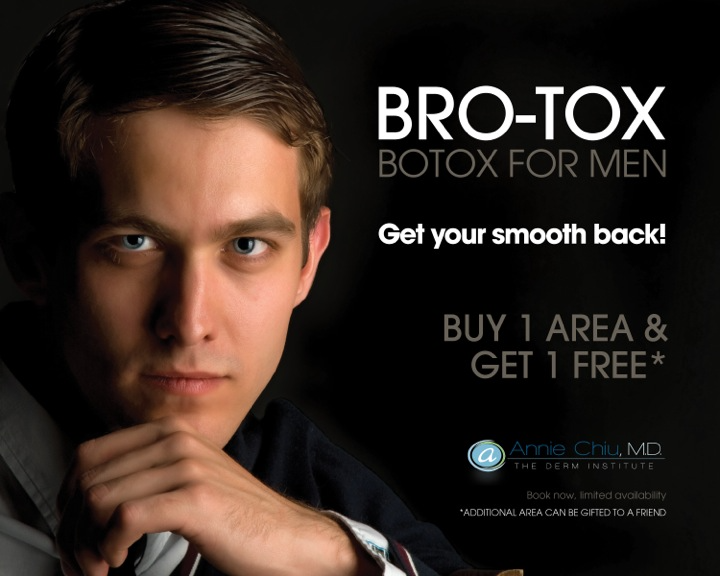
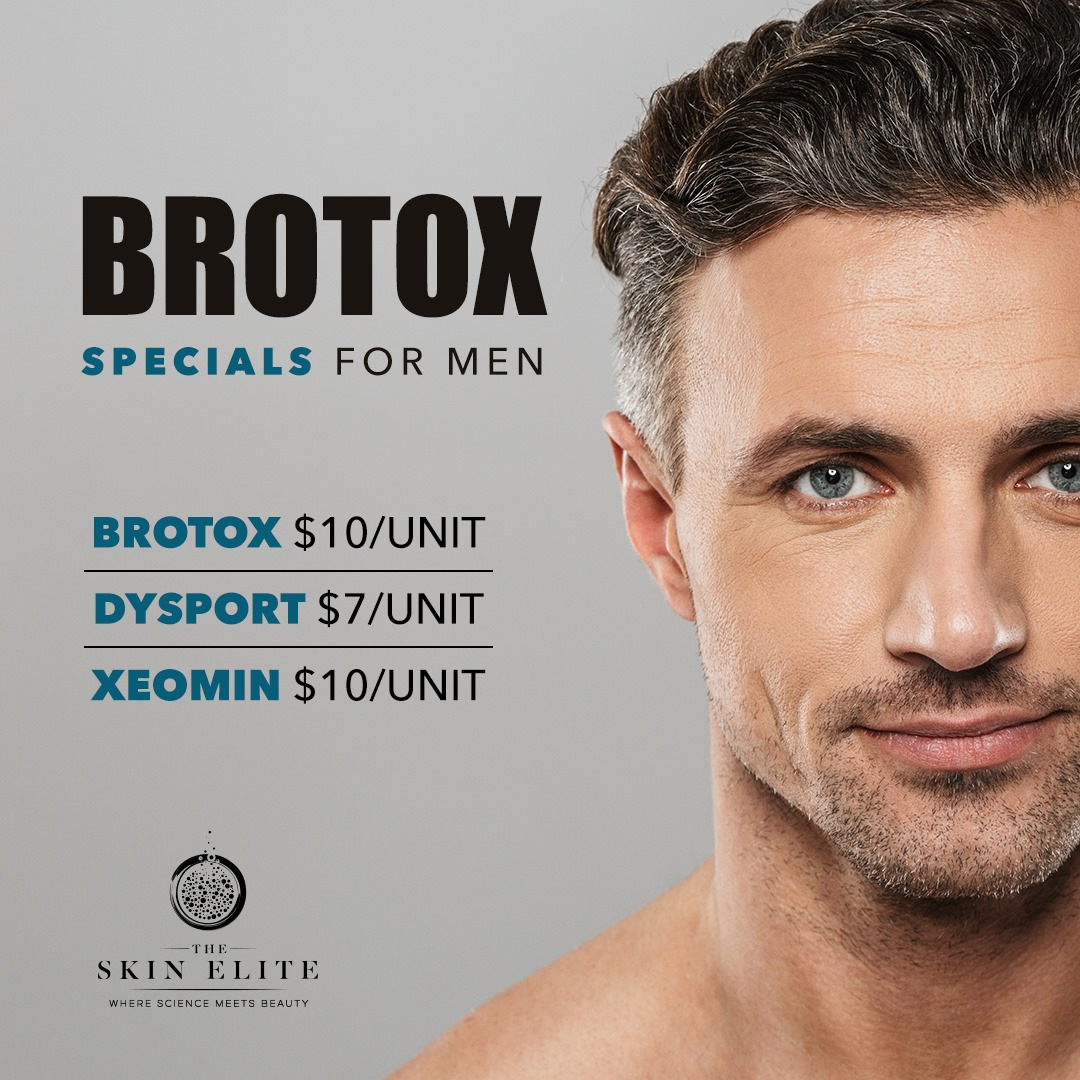
Rather than the typical aesthetic marketing approach - all wrapped up in pinks and pastels with soft lighting and imagery that screams "this is for women only":
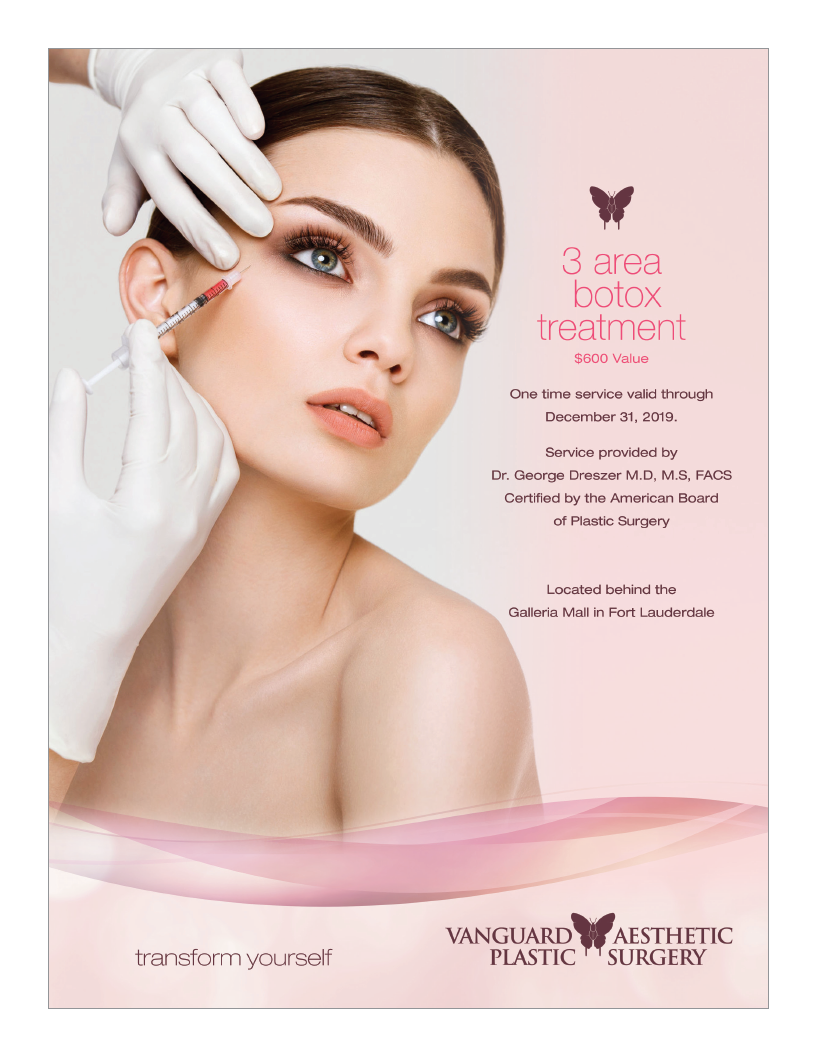
Website
You have two options for creating a David-friendly web presence, and the choice depends on your resources and how committed you are to the male market:
Option 1: Create a men's section
Add a dedicated men's area to your existing website. This is the easier, more budget-friendly approach. You keep your current site for female patients and create male-specific pages with different messaging, visuals, and content:
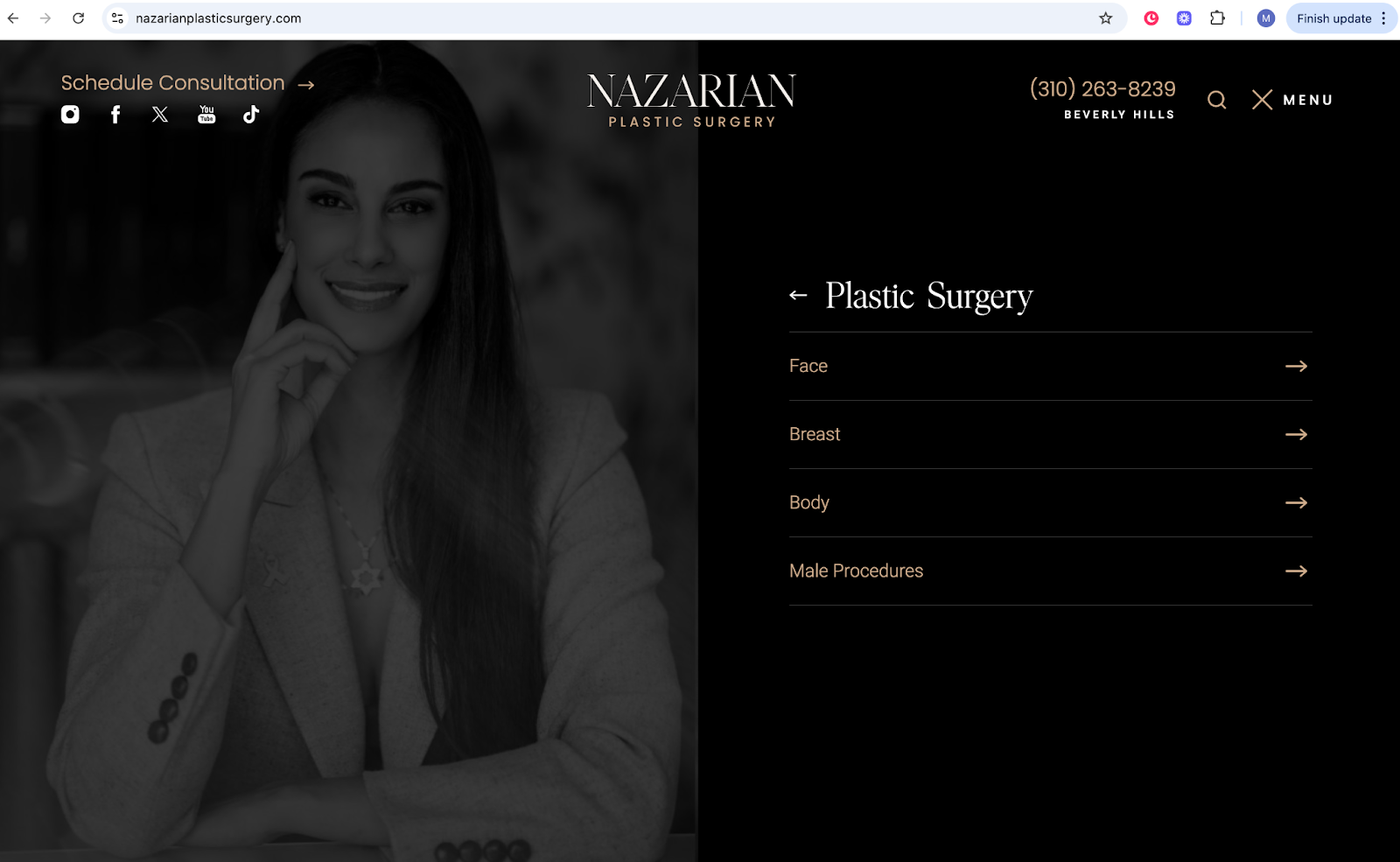
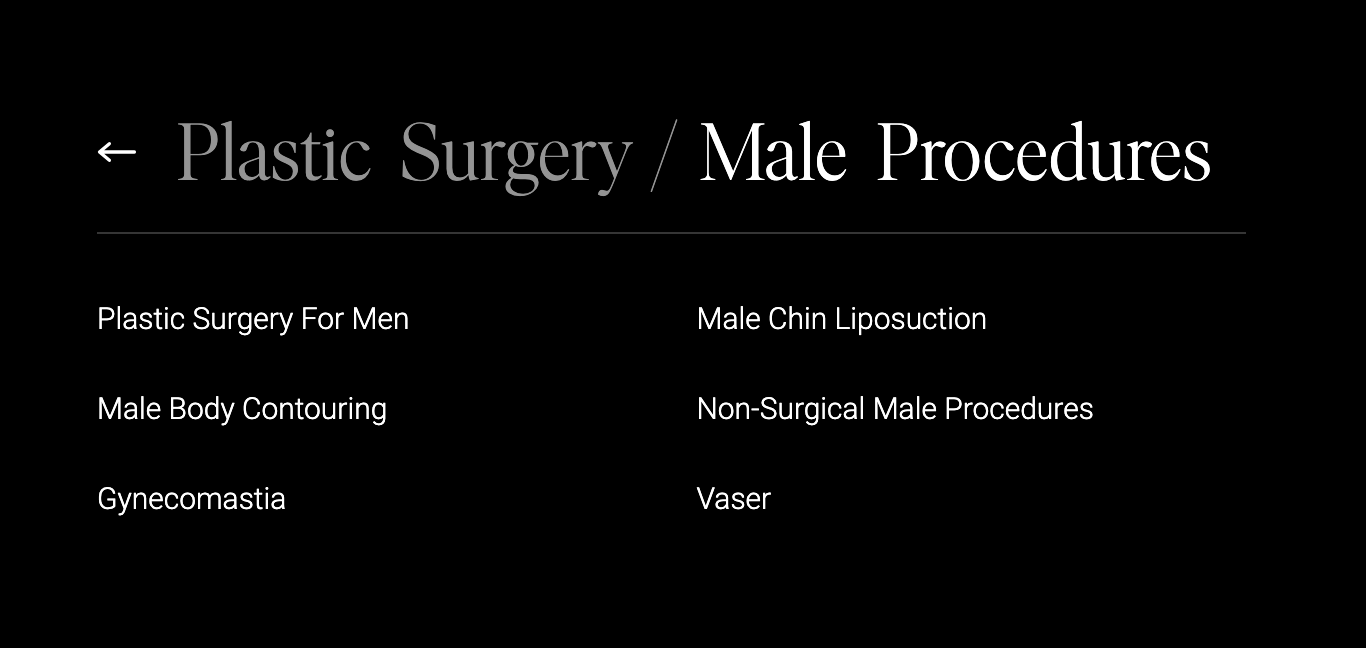
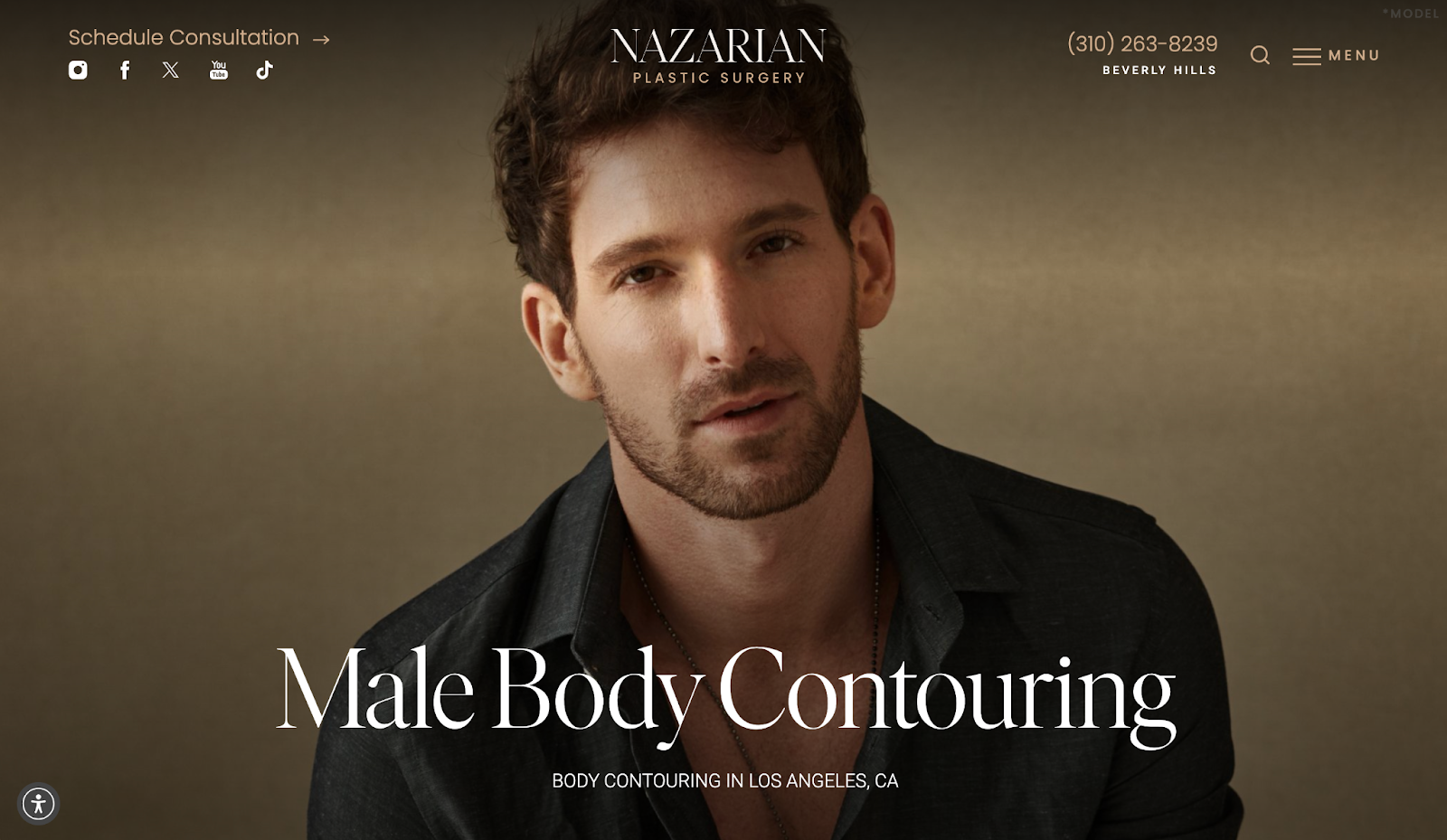
Option 2: Build a Separate Male-Focused Identity
Create an entirely separate website (or subdomain) designed specifically for men. This is the premium approach - more expensive, more work, but potentially more effective for practices serious about capturing male patients:
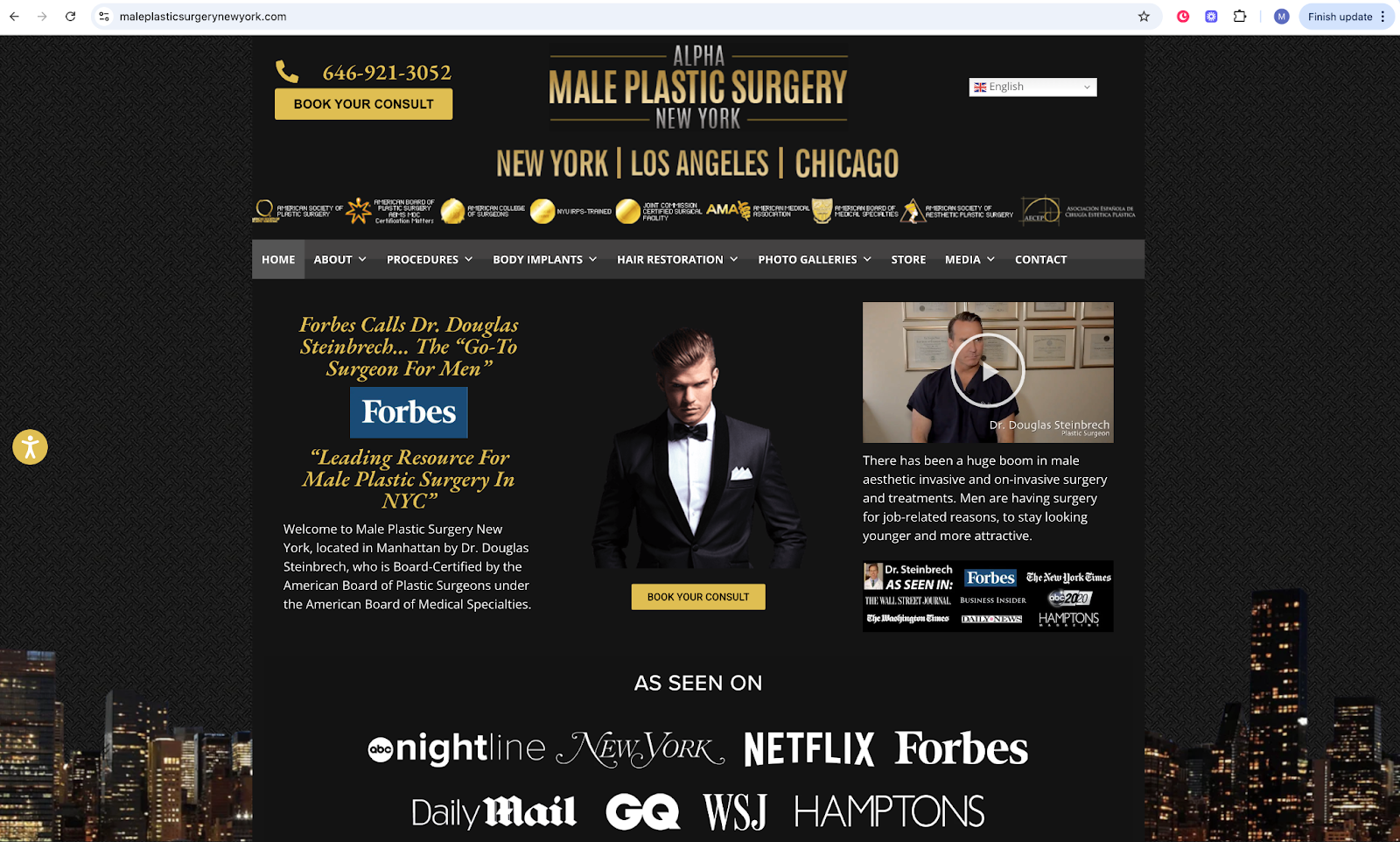
By creating a separate identity, you can optimize everything - from the domain name, through content, to custom procedures for male patients:
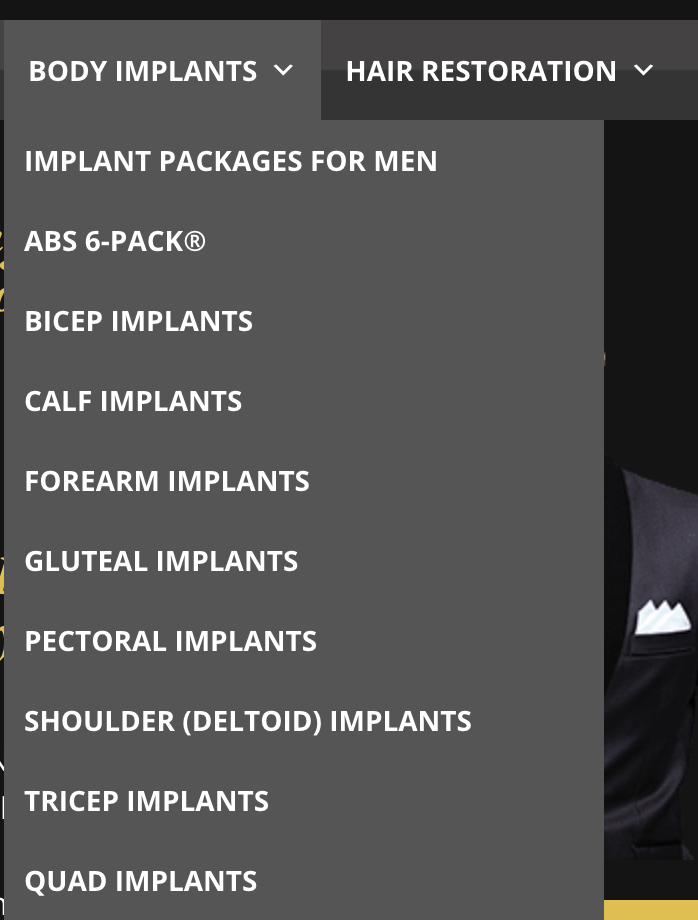
But what exactly should a truly male patient–optimized website include?
Educational Content
Your current content probably sounds like it was written by a committee of medical textbook authors who've never had a normal conversation in their lives. You're throwing around terms like "cryolipolysis" and "exosomes" like David's supposed to know what any of that means.
Newsflash: He doesn't.
That's why educating David needs to begin at ground zero. Don't assume he knows anything about aesthetics. Start with the absolute basics:
- What aesthetic medicine actually is
- The difference between surgical and non-surgical treatments
- How these treatments actually work
The goal isn't to dumb it down - it's to make it accessible. David didn't go to medical school, but he's smart enough to understand how treatments work if you explain them like a normal person instead of a wikipedia page:
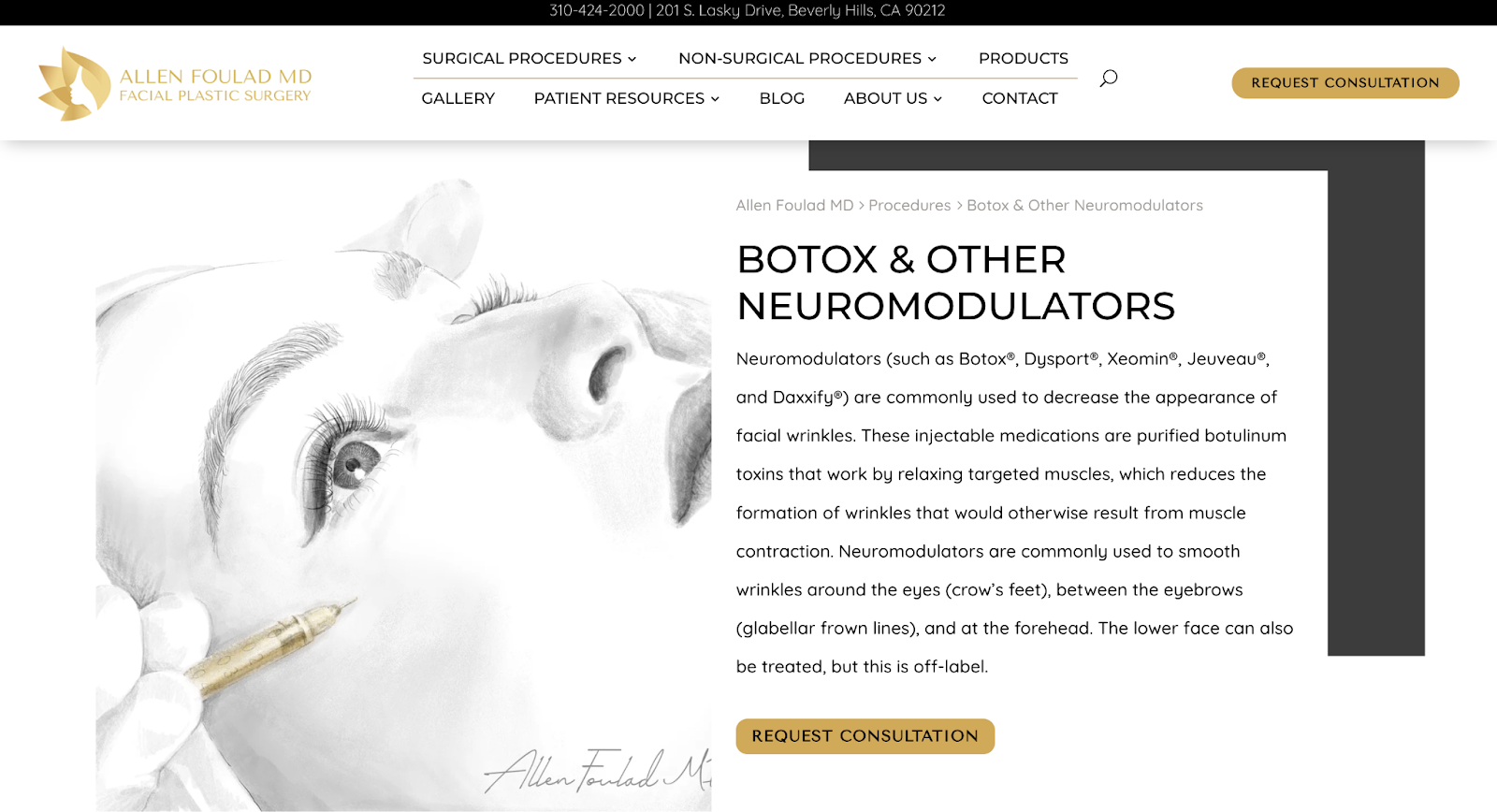
Dysport? Purified botulinum toxin? Neuromodulators?
Without any further explanations, to David, this sounds like you're recruiting volunteers for some sketchy medical experiment. You need to start with the basics - in a friendly, simple language:
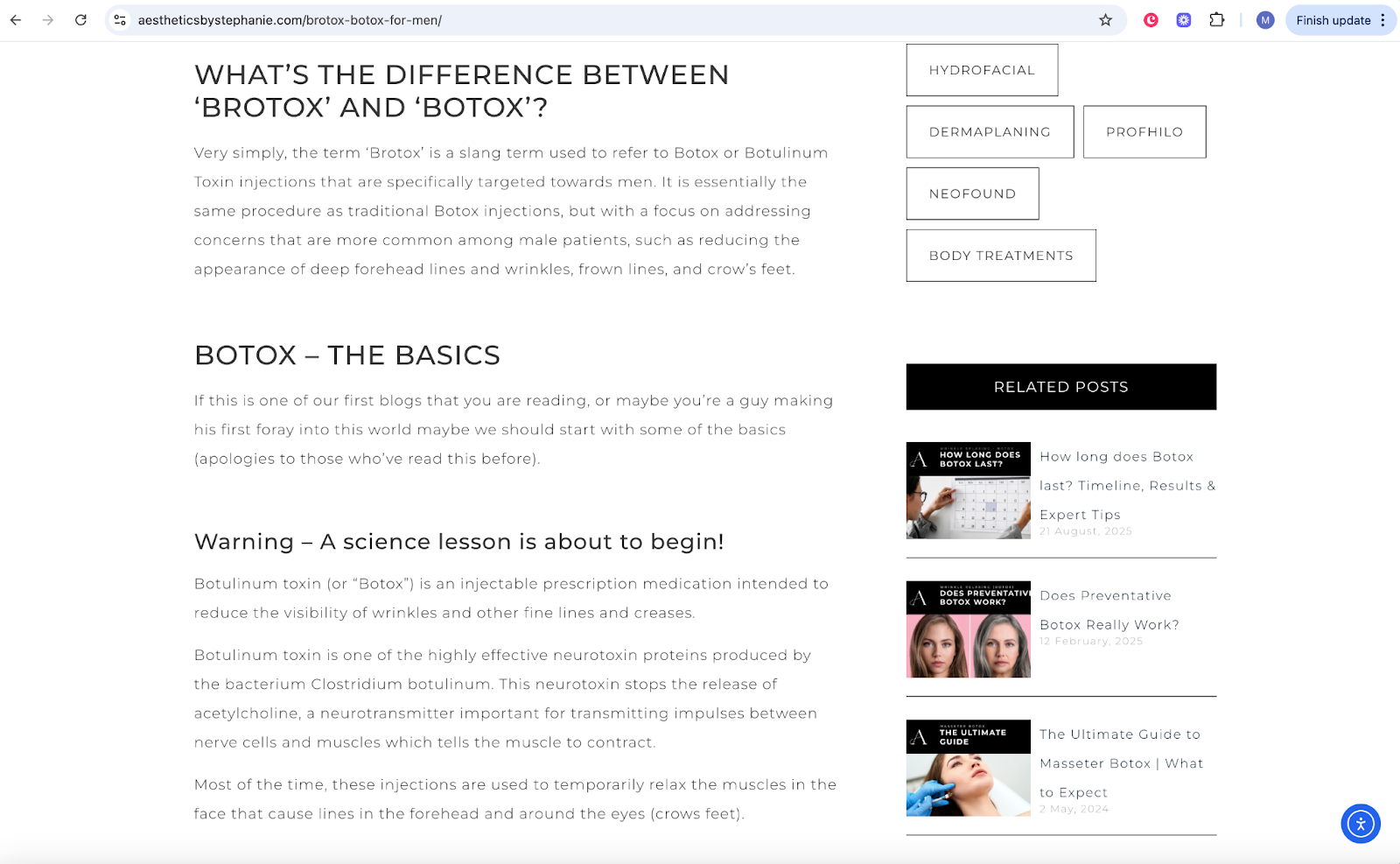
Educational content is where you win or lose David. And remember: you're not just educating him about treatments - you're educating him that aesthetic medicine is something normal, successful men do to solve practical problems. Your content needs to give him both the information and the permission to proceed.
Copy and CTAs
Here's a fun idea: go read some of the copy on your website out loud and imagine David sitting across from you. Every time you say something like ✨enhance your natural beauty ✨ or ✨discover your radiant self ✨, picture his face.
Spoiler alert: he's not exactly vibing with what you're saying. In fact, I can see him giving me a side-eye and going "Man, I think we're in the wrong place."
The aesthetic industry has trained itself to speak in the aspirational, flowery language that resonates with most women. The problem is, this kind of language makes the majority of men feel like they accidentally wandered into a poetry reading when they were looking for a hardware store.
After all, David approaches appearance concerns completely differently than women would. He wants practical solutions (with a side of reassurance) delivered in straightforward language - not descriptions of transformation experiences that sound like they belong in a women's lifestyle magazine:
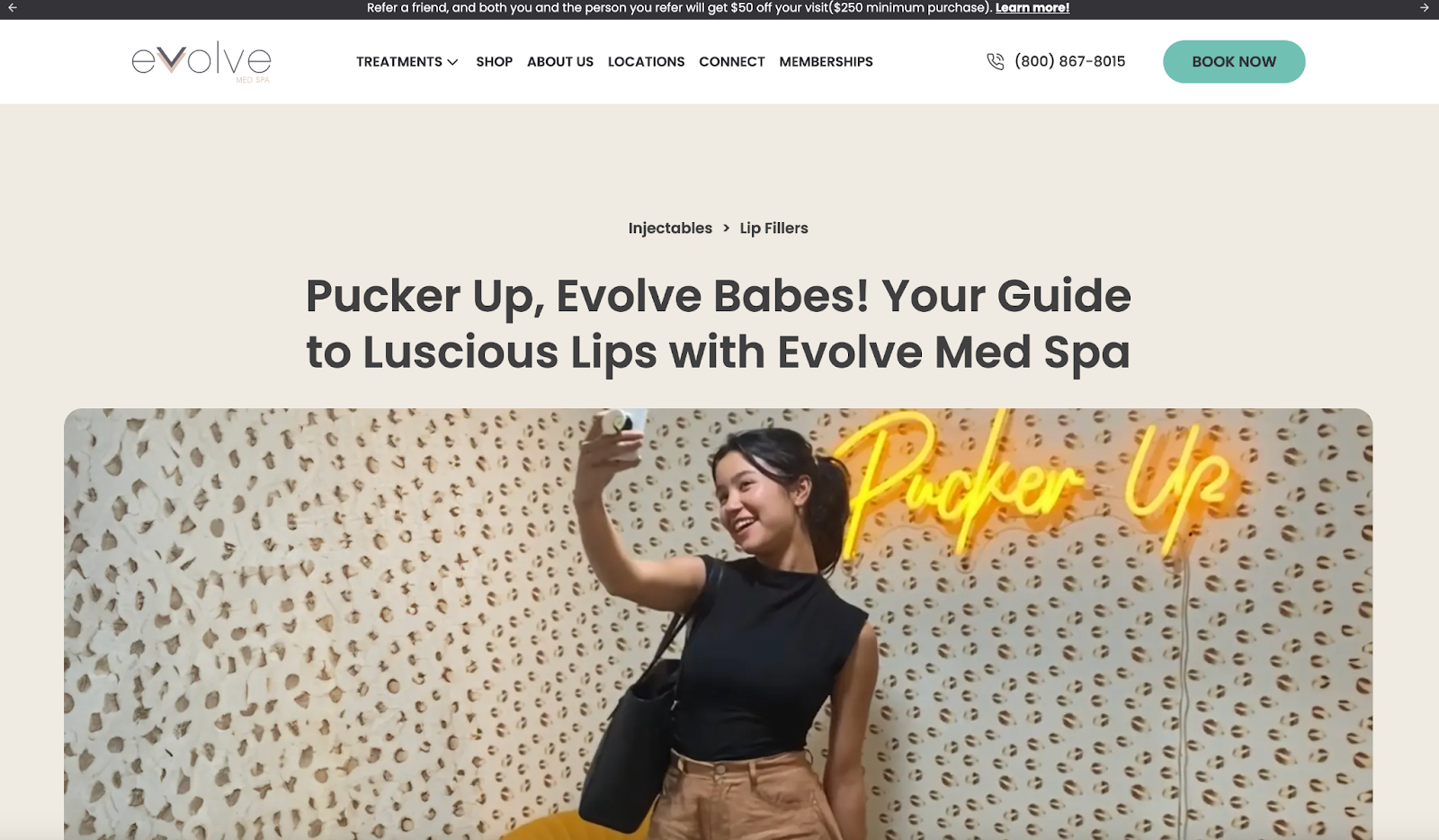
Come on David, pucker up, babe!
That’s why you need to ditch every mention of "beauty," "radiance," etc. Replace them with problem-solving language that addresses what's actually bothering David. Talk about looking more alert, professional, younger, or confident - outcomes he can visualize and value.
And when David's ready to hit that CTA button, make sure it will also resonate with him. Stick with straightforward action words that feel like normal business interactions - scheduling, booking, getting started, or learning more. You know, like a regular human being making a regular appointment, not someone embarking on a quest to find their inner goddess.
Visuals
The visual design on your website is doing all the talking before your copy gets a word in, and right now it may be telling David your practice is definitely not a place where he belongs.
So, what male-optimized visuals look like?
Color themes: Navy, charcoal, steel gray, black, white:
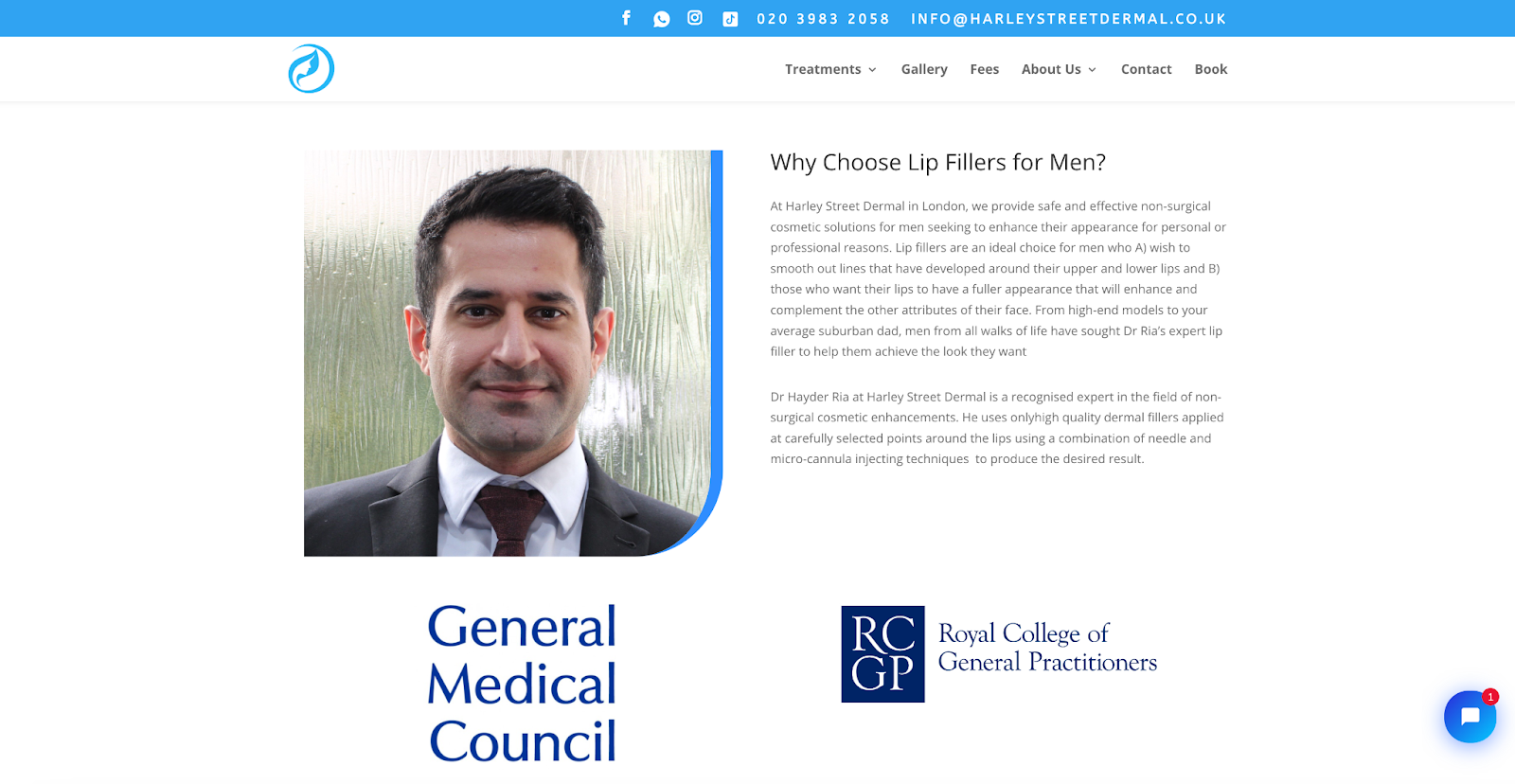
These aren't just colors - they're a non-spoken language that reassures David is right where he should be.
Typography: Clean, modern sans-serif fonts:
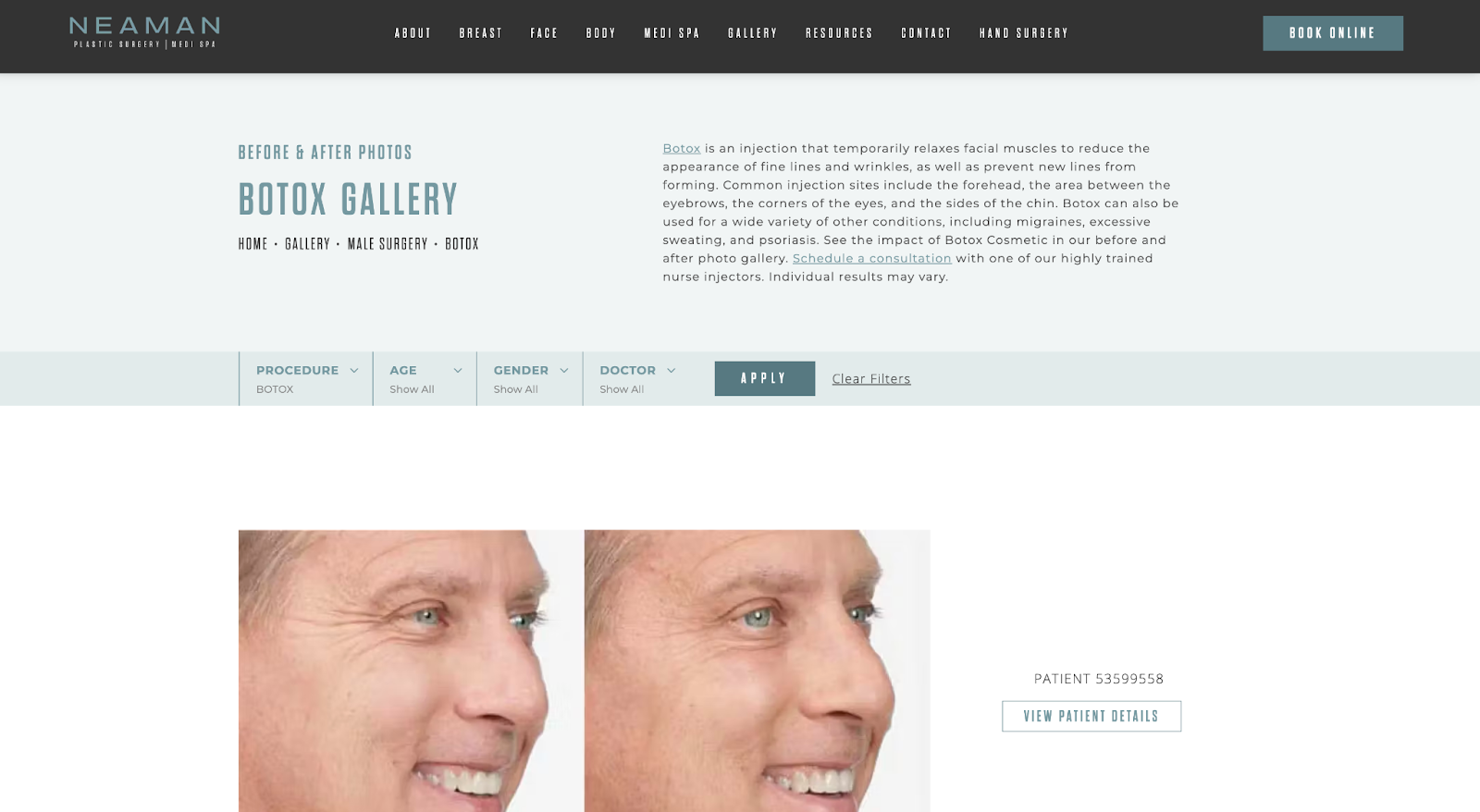
None of the swirly, elegant scripts that look like they were designed for wedding invitations. David wants information delivered like he's reading the Wall Street Journal. Clean, efficient, business-focused.
Professional photography:
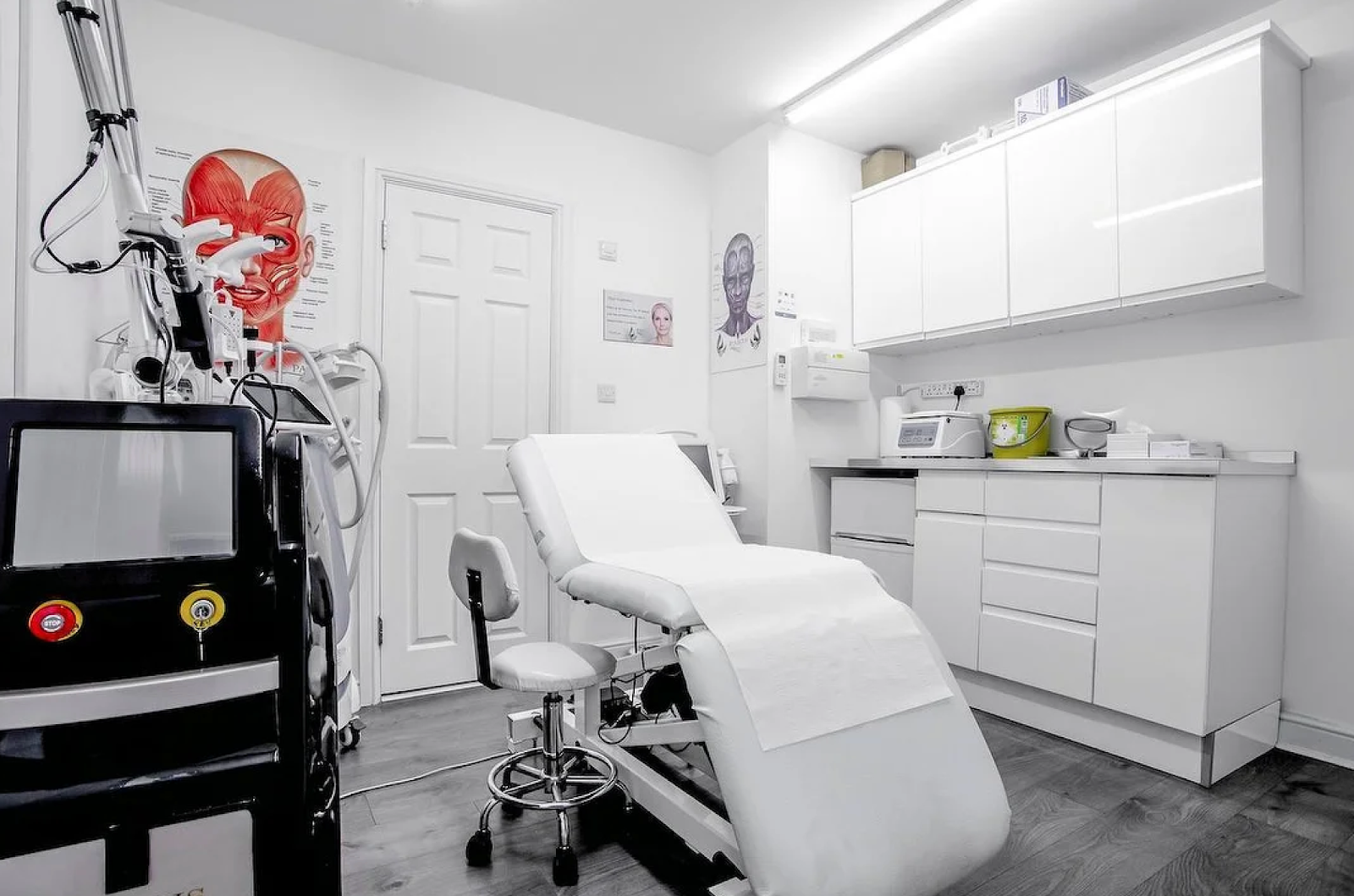
Show David clean facilities, professional setups, and environments that show medical excellence. No flowers arranged for Instagram, no potpourris, and definitely no inspirational quotes written in cursive on the walls.
Male before-and-afters:
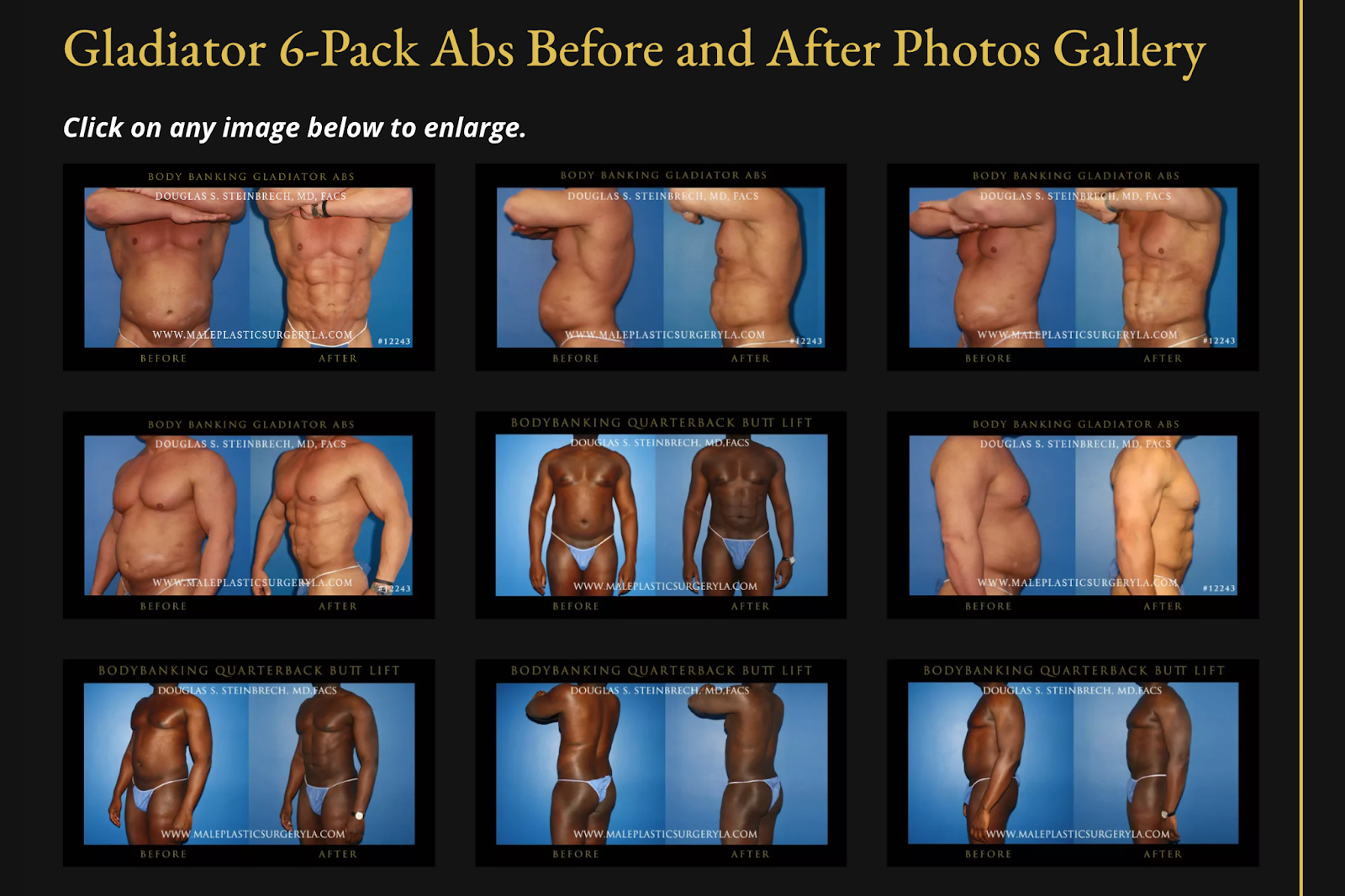
Look, I can't stress this enough, but if there's one visual element that makes or breaks your male-optimized website, it's prominent male before-and-after photos. Not tucked away in some gallery David will never find. Not mixed in with dozens of female results. Front and center, impossible to miss.
David needs to see the treatments working on guys who look like him, dress like him, and probably stress about the same things he does. If he can't picture himself getting those results, you've already lost him.
If you don't have enough male before-and-afters to showcase properly, stop what you're doing and make this priority number one. Everything else - the campaigns, the copy, the clever marketing strategies - is just noise if David can't see himself in your results.
Testimonials from Other Men
David needs reassurance on multiple levels, and male testimonials are your most powerful tool for providing it. He needs to know that other guys like him - professionals, regular guys with similar concerns - have gone through this process and gotten masculine, natural-looking results:
Give him that comprehensive social proof and you've solved his two biggest barriers:
- The fear that he'd be the only man making this choice,
- The fear that he'll end up with results that don't suit his masculine identity.
The bottom line is, whether you choose to create a men's section or build a completely separate male-focused site, the key is speaking David’s language, addressing his concerns, and making him feel like aesthetic treatments are a perfectly fine thing to do for a modern masculine guy.
After all, your website is often the first interaction potential male patients have with your practice. So if it looks and sounds like it was designed exclusively for women:
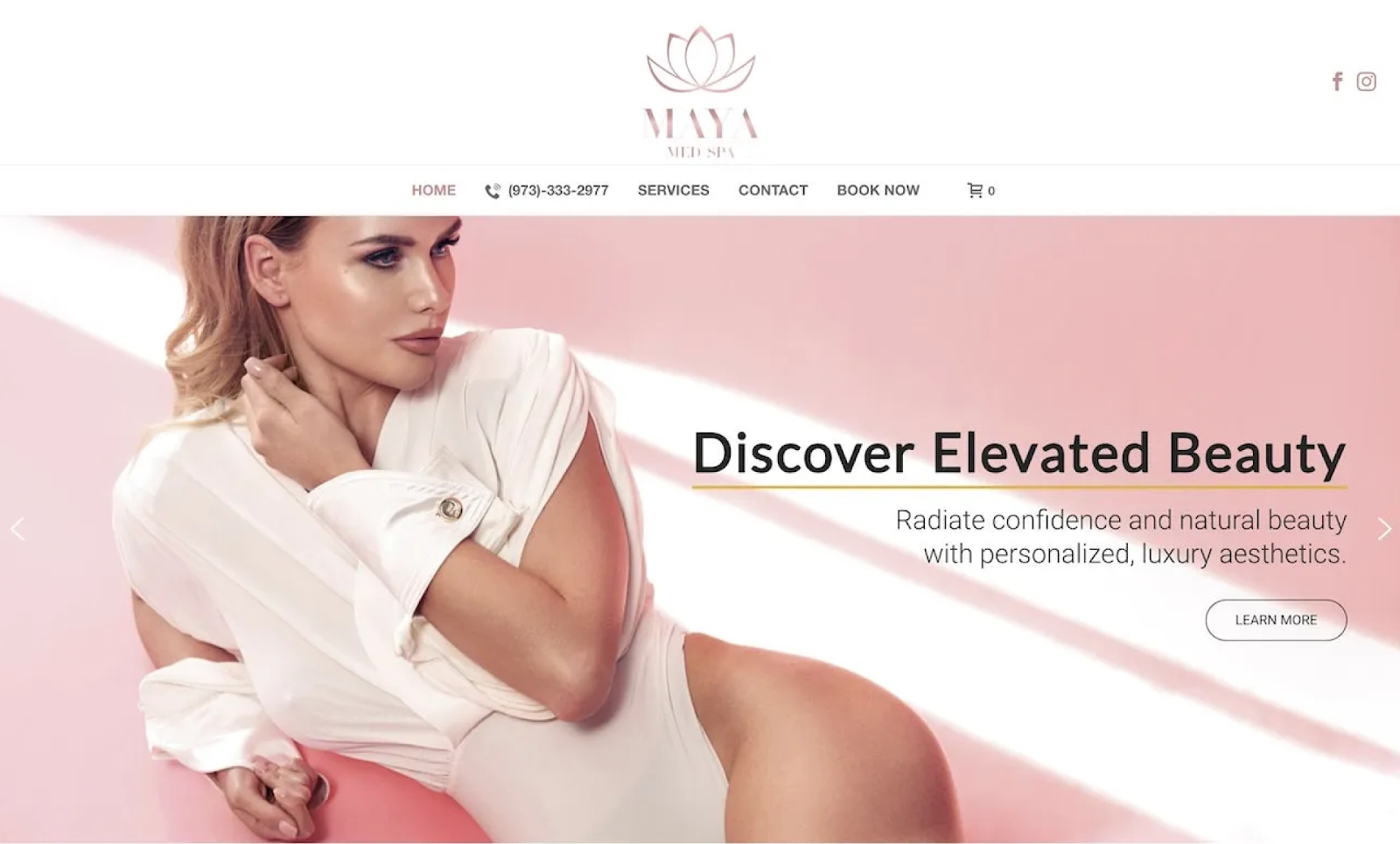
...You're losing David before he even learns how you can actually help him.
Social Media
Take a scroll through your practice's social media right now. If it looks like every other aesthetic account - soft pastels, women in spa robes, endless female before-and-afters, and captions about "glowing up" - you've just figured out why David isn’t one of your followers yet.
What should you do instead?
Feature male before-and-afters consistently:
Stop treating male transformations like rare unicorn sightings. Post male results regularly - not as an afterthought, but as a core part of your content strategy. Show men getting Botox, CoolSculpting, hair restoration, whatever services you offer that can be helpful for male patients.
Educational content:
Create content that explains how treatments actually work, what the process looks like, recovery timelines, when he'll see results. As I’ve already mentioned, David is at level zero when it comes to aesthetic medicine knowledge - and you need to be his guide.
Social normalization:
Show that other men like David also undergo aesthetic treatments. Share statistics about male aesthetic patients or content that normalizes the idea that caring about your appearance is something successful, masculine guys also do.
Create content that pulls back the curtain:
What a visit looks like, how to prepare for a consultation etc. Make David feel like the process is approachable and professional.
Demonstrate your male-specific expertise:
Share content that shows you understand David's unique needs and concerns. Discuss how you modify techniques for masculine facial structure, how you customize treatment plans for male patients, and how you acknowledge the specific results he wants.
Address male concerns directly:
Create content that tackles the questions David has but might be embarrassed to ask: "Will people notice I had work done?" "How long until I can exercise?" "What if my colleagues find out?" Educational content that talks about these concerns head-on positions you as someone who truly understands the male patient experience.
At the end of the day, the main goal of your social media content is for David to think "This place totally gets me" instead of "Maybe they accidentally treat some men too." That’s why showing male results consistently, educating comprehensively, and demonstrating that you understand what men actually want from aesthetic treatments is the key to success.
Indirect Marketing
But here's where it gets interesting. Sometimes the most effective way to reach David is through marketing he doesn’t even realize is targeting him.
Just think about it - David's spent his entire life avoiding beauty and wellness marketing. He's built mental filters that automatically dismiss anything that feels too aesthetic-focused. But what if you could reach him through channels he trusts, people he listens to, and situations where he's already comfortable?
The Girlfriend Strategy
Let's give credit where credit is due: a significant number of men are walking into aesthetic clinics because their partners suggested it.
Gentlemen, before you may get defensive about this - myself included - let me ask you something:
Who chose those new cushions for your living room - you know, the ones you never wanted in the first place? Who booked your last doctor's visit? Who's been diplomatically suggesting you try aesthetic medicine for those deep frown lines that have been giving you a permanent angry face?
(I say this as I'm sitting here in one of the shirts my girlfriend picked out for me)
The ladies in our life have a tremendous influence on us. Girlfriends and wives have been the gateway drug to male aesthetic treatments for years. They start with gentle suggestions, progress to gifting skincare products, and eventually graduate to booking the appointment themselves:
That’s the genius of the girlfriend strategy: it bypasses David’s resistance almost entirely. By the time he’s sitting in your consultation room, someone else has already done the heavy lifting—researching treatments, making decisions, and even scheduling the visit—following the “traditional” female journey in aesthetics.
That’s exactly why smart practices don’t fight this dynamic—they leverage it. And you can do it too. There are a few simple tactics:
- Create content that speaks directly to women who want to help their partners look and feel better
Your messaging should speak directly to David’s girlfriend. She sees his potential. She wants him to feel confident. She’s the one who can make the experience approachable, comfortable, and even exciting. Show her how other women have done it: they encouraged their partners, helped them understand the process, the men ended up going—and loving the results later.
After all, David’s not involved in this journey—it’s his girlfriend who has the comfort level to fluently navigate aesthetic services that he’s hesitant to explore on his own.
- Showcase couples' transformations and market "His & Hers" packages:
When treatments are positioned as something couples do together, David doesn’t feel the pressure of breaking the barrier and beginning his own aesthetic adventure; in fact, he doesn't even have to admit he actually wants the treatment.
He's just participating in the "stupid" couples package his girlfriend researched and booked. She did all the homework, figured out the logistics, and presented it as a cute couples’ activity that David will later tell his buddies "his GF made him do". He gets exactly the results he's been quietly wanting without having to own the decision or deal with any of the uncomfortable parts of the process.
- Position treatments as gifts for men rather than self-purchases:
Market gift cards and treatment packages specifically for women to give their partners. Think of it as the ultimate win-win. He gets sharper jawlines, smoother skin, and a newfound confidence. She gets bragging rights for orchestrating the perfect gift and proving she knows him better than he knows himself.
And you? You get the patient who’s already pre-sold, completely unresistant, and blissfully unaware he just went through the aesthetic equivalent of a surprise party.
Reach Other Men in Their Lives
David doesn't scroll through aesthetic content - in fact, he probably hasn’t seen even one post from an aesthetic practice on his explore page. But what he absolutely is listening to is his business coach's podcast during his commute, binge-watching fitness creators, and following guys who have very strong opinions on how to grill a perfect brisket.
These men already have David's trust and attention, and they're perfect for introducing aesthetic treatments within contexts he's already comfortable with:
And here's the beautiful part: when a business coach mentions that executive presence includes not looking exhausted, or when a fitness influencer says some areas won't respond to diet and exercise, David doesn't register it as aesthetic medicine marketing.
He processes it as practical advice from someone whose judgment he already trusts.
Same Destination, Different Path
Most practices think male patient marketing means slapping a “FOR MEN” sticker on everything and calling it a day. Nothing could be further from the truth.
Marketing to male patients isn’t rocket science, but it does require a deep understanding of how David makes decisions, what motivates him, how to connect with him on a visceral level, and how his journey varies from a woman’s—battling stigma and the weight of toxic masculinity along the way.
The destination, however, is the same for both genders: confidence, aesthetic improvement, and a sense of self-actualization. The difference lies in the path to get there.
And while every practice is fighting over the same female demographic, there’s a largely untapped market of men waiting for someone to guide them through their own aesthetic journey. The practices that crack this code aren’t just gaining a few extra patients—they’re dominating a profitable, underserved audience that’s ready to engage and invest.
David and his buddies have been waiting for you to figure this out for years. The real question is: would they feel welcome in your aesthetic practice today?
Too Long? Here's the Short Version
Men want aesthetic treatments—but they're not booking appointments. The barriers? Masculine stigma, fear of judgment, and an industry that excludes them entirely with female-focused marketing. But this untapped market doesn't just need to be included—it requires a fundamentally different approach: problem-focused SEO, male-optimized websites with prominent male before-and-afters, straightforward language emphasizing practical results rather than beauty, education starting at zero, and indirect marketing through partners or male influencers. After all, the end destination in aesthetic medicine is the same for both genders—confidence and aesthetic improvement—but the path to get there is anything but.
Men want aesthetic treatments—but they're not booking appointments. The barriers? Masculine stigma, fear of judgment, and an industry that excludes them entirely with female-focused marketing. But this untapped market doesn't just need to be included—it requires a fundamentally different approach: problem-focused SEO, male-optimized websites with prominent male before-and-afters, straightforward language emphasizing practical results rather than beauty, education starting at zero, and indirect marketing through partners or male influencers. After all, the end destination in aesthetic medicine is the same for both genders—confidence and aesthetic improvement—but the path to get there is anything but.










